Intel Core i9-13900K and i5-13600K Review: Raptor Lake Brings More Bite
by Gavin Bonshor on October 20, 2022 9:00 AM ESTClosing Thoughts
When Intel officially announced Raptor Lake back at Intel Innovation 2022, it coincidentally fell on the same day that AMD's latest Ryzen 7000 processors were made available in retail stores. Although it did take a little bit of sting out of AMD's launch, that's something that's become par for the course in what's become a highly competitive consumer CPU market. Now Intel's 13th Generation Core processors are here, and following AMD's well-received Zen 4 launch, the biggest question to be answered today is "how has Intel responded?"
Getting straight to the point when it comes to analyzing the Raptor Lake platform and Intel’s new Raptor Cove performance (P) cores, there’s no escaping the fact that it feels like Alder Lake 2.0. Which isn't a bad thing given how competitive Alder Lake was when directly compared against AMD’s Ryzen 5000 series, both in regards to performance and price. Intel had a strong platform with Alder Lake, one that the company believes is strong enough to keep up with AMD's latest with the addition of a few performance tweaks.
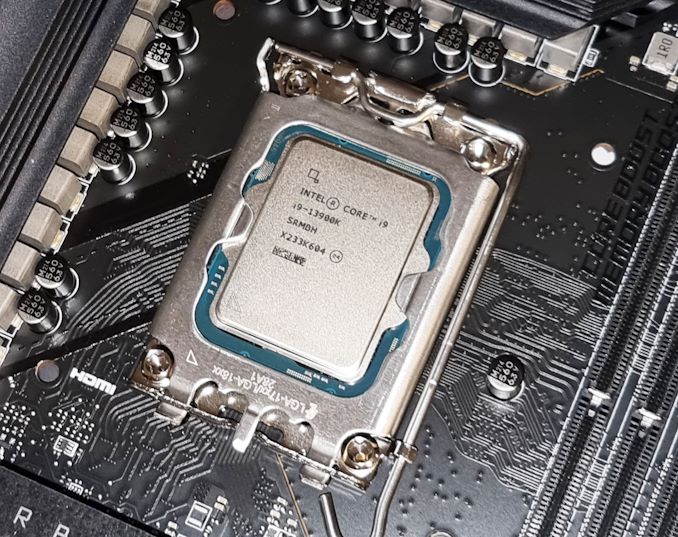
Intel Core i9-13900K installed into an MSI MPG Z790 Carbon WIFI motherboard (LGA 1700)
The biggest improvement over Alder Lake comes through an improved and more optimized voltage frequency (V/F) curve, where Intel has squeezed out an extra 200 MHz at iso-voltage, or a reduction of 50 mV at iso-frequency. These benefits are clear to see, especially with the very high turbo core frequency of up to 5.8 GHz on the Core i9-13900K. It’s worth mentioning that this is actually 5.7 GHz when temperatures rise above 70°C, as per Intel’s Thermal Velocity Boost (TVB) technology, or when the power limits allow it; so these highest clockspeeds are attained mostly in single-threaded applications rather than multi-threaded.
Of course, the fact that Intel has now doubled the number of efficiency (E) cores compared to Alder Lake should not go unmentioned. This means the Core i9-13900K now has a total of 24 CPU cores (8P+16E), making for a total of 32 threads. Meanwhile the Core i5-13600K has 14 cores, with 6P+8E, up from 10-cores (6+4E) on the previous Core i5-12600K. With more efficiency cores, the levels of performance in multi-threaded applications have also gone up, but not without increasing the PL1/PL2 limits to 253 W. As a result, Raptor Lake draws more power than its predecessor, but performance levels have also risen generationally speaking.
Also contributing to Intel's gains here are a few cache and other memory improvements. Both the P and E-cores have larger L2 caches for better hit rates, and the L3 cache size has been scaled up to accommodate the larger number of E-cores, bringing the top-end 13900K to 36MB of L3. All of the Raptor Lake chips are also validated for faster DDR5 memory support, allowing them to run at DDR5-5600(B) before any memory overclocking. While not as significant as merely adding more cores or higher clockspeeds, these changes help Intel squeeze out a bit more performance from what is essentially an evolved Alder Lake design.
Intel 13th Gen Core: Moving Ahead, Highly Performance Competitive with Zen 4
Looking at how the performance of Intel's latest 13th Gen Core series processors compares to AMD’s Ryzen 7000 series, there are certain aspects to like about both efforts. The two lineups can be very competitive, depending on the type of workload undertaken; some benchmarks we’ve tested favor the Zen 4 core, and others put the highly clocked Raptor Cove P-cores ahead. And others still favor Intel’s adding more cores overall, even if they're only efficiency cores.

A little less than a month ago we saw AMD’s Ryzen 9 7950X hit 38K in Cinebench R23’s multi-threaded test, Intel has now gone one better. The Core i9-13900K has broken the 40K mark, and we're seeing pretty good rendering performance from the Core i5-13600K, too. The Core i5-13600K throughout the majority of our testing puts it close to the level of the Ryzen 9 5950X and the Core i7-12700K, which makes for a good value given its $319 MSRP.
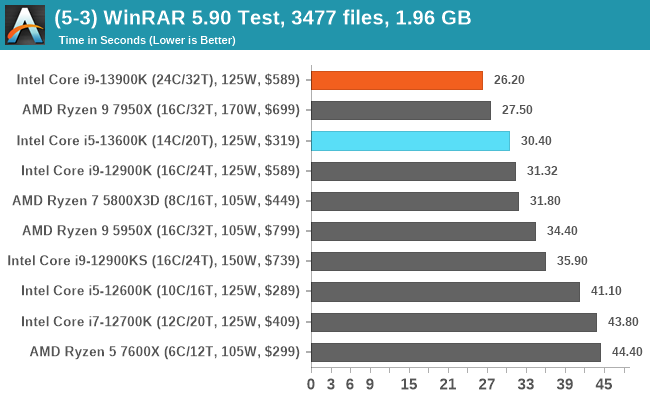
In the bulk of our testing, things really came down to what workload is favored by which core architecture. We saw extremely potent simulation performance from the Core i9-13900K, while the Ryzen 9 7950X does exceptionally well in encoding. Making judgments on performance across the multiple areas of compute, the CPU performance lead is a consistent battle across our entire benchmark suite.
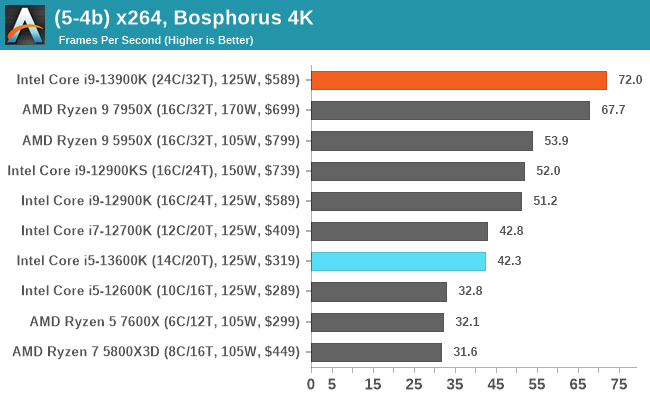
This is how close overall performance is, and the crux of it is, Raptor Lake is a revamped core, and Zen 4 is on a new process node (5 nm). Either way, Intel looks very good here, especially in terms of pricing.
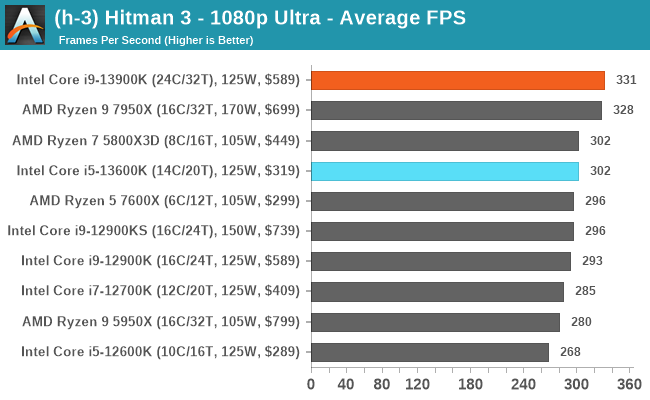
When it comes to gaming performance, both AMD and Intel boldly claim that their latest processors provide solid improvements in frame rates. Against previous generations such as the Ryzen 5000 series and Intel’s 12th Gen Core series, Intel has been able to deliver on those claims; though both AMD and Intel still fall to the unique Ryzen 7 5800X3D and its 96 MB of 3D V-Cache from time to time.
Trying to decide who has the edge when it comes to gaming really comes down to what title it is, what resolution you’re gaming at, and what money you want to spend. Theoretically, even the Core i5-13600K at $319 is very competitive against the more expensive flagship offerings. In fact, despite how good the Core i9-13900K and the Ryzen 9 7950X are in terms of powerful compute performance, the unsung hero when trying to find a bit of value in the current global financial climate could easily be Core i5-13600K.
Raptor Lake and Zen 4 Flagships Trade Blows: But Where's the Value?
Most of the talking points are understandably going to be focused on Intel and AMD’s latest flagship processors, and quite rightly so, as these are the chips pushing the envelope in terms of CPU performance. In the case of the Core i9-13900K, the improvements that Intel has delivered on via higher clockspeeds, more cache, and more E-cores delivers a tangible (and in some cases, significant) performance improvement. As a result Raptor Lake is on a level performance footing with the powerful Ryzen 7000 series.
But Intel is doing this at a much more competitive price point; not just at face value with chip MSRPs, but on additional costs such as cheaper motherboards than what's available for the brand-new AM5 platform. It's a similar story for memory support, as Raptor Lake (still) features support for both DDR5 and DDR4 memory, while AMD’s limited Ryzen 7000 support to DDR5 only. Granted, you will lose performance going with slower memory, but for the price-conscientious, the option is at least there.
As many have voiced concerns about it on social media, Reddit, and online communities, trying to find that value factor in Zen 4 has is a difficult task. Yes, Zen 4 has more affordable processors, but factor in a brand new AM5 motherboard and some DDR5 memory, and the total price tag can quickly add up.
Touching on platforms, Intel’s existing Z690 platform offers support for 13th Gen Core series processors, and as Intel has claimed, there shouldn't be any CPU performance differences between the new Z790 and the current Z690 chipset. The only real differences coming through I/O, with more PCIe 4.0 lanes available from the Z790 chipset (x8), at the cost of the same amount of PCIe 3.0 lanes. This allows motherboard vendors to add more exotic controllers such as Thunderbolt 4 or leverage more M.2 slots.
So where’s the value? Well, the value looks to be in the Core i5-13600K, which if you consider that the 13th Gen Core i5 is now a 12-core part, offers up some stiff competition to the previous generation Core i7-12700K and in some cases, the Core i9-12900K. Add that to the fact you can pair this with a cheaper Z690 or B660 motherboard and go with DDR4 memory, and that extra budget saved can go to another area such as graphics or storage.
If however if raw horsepower-driven performance is exactly what you’re after for tasks such as rendering, video editing, and encoding, then the Core i9-13900K certainly does tick the right boxes. First of all, it trades blows with the more expensive AMD Ryzen 9 7950X, so technically both brands share the crown now depending on the workload undertaken. Secondly, elaborating on the first point, the Core i9-13900K ($589) is around $100 cheaper than the Zen 4 flagship, which sweetens the deal somewhat.
You will likely, however, end up paying back at least some of the difference over time in regards to power consumption. While Intel has put together a very competitive chip, they've also put together a chip that will guzzle power when allowed to – even more so than 12900K(S). In our testing, power consumption topped out at a absurd 335 Watts, over 100W more than the Ryzen 9 7950X. Those high frequencies and the additional E-cores don't come for free, even with Intel's v/f curve improvements reducing the cost.
The wildcard factor here is that what 13900K can draw and what it's allowed to draw are not always the same thing. As has been the case for a few generations now, motherboard vendors have been more than happy to remove (or at least greatly increase) the PL2 limits on high-end Intel boards by default, all in the name of eking out every last bit of performance. And that gap between PL2 and the natural limits of a chip has never been wider for Intel. Raptor Lake brings a lot of bite, but it also bites back.
A motherboard that actually follows Intel's rules and caps PL2 at 253 Watts would net a significant power reduction, but the performance results would suffer as well – likely by just a couple of percent, given how far up the v/f curve the 13900K is. Meanwhile all of this sits in notable contrast to the AM5 platform, which, at least in our launch testing, did not exceed AMD's equivalent metric, PPT, which is 230W. So as measured out of the box, AMD has a very obvious energy efficiency advantage in the desktop market right now.
Ultimately, as we test the defaults for a chip/platform as much as possible, the 335W peak figure is accurate for what self-builders are going to see out of the box if they assemble a high-end 13900K system. OEM systems and self-builds using more modest motherboards, on the other hand, are far more likely to respect PL2, reducing power consumption and performance in the process.
Given the rise in energy costs this year (especially in Europe), this probably isn't great timing for a 335W consumer CPU. Still, it is what it is, for better or worse. But the silver lining is that all that configurability that lets PCs overclock can also be used in reverse to cap power consumption. So as part of our follow-up testing will be playing with power for both AMD and Intel's latest chips, to see where performance lies when various power limits are in place.
Final Thoughts: Competition is Healthy, and Necessary
Power aside, AMD and Intel are both in very competitive position right now. Despite coming at the problem of PC performance with two vastly different architectures (who had Intel leading the core count wars on their 2022 bingo card?), the two have arrived at very similar places with regards to CPU performance. Sometimes they tie and sometimes they do not, but both vendors largely trade blows in equal amounts. To put it another way, the Core i9-13900K (and Raptor Lake as a whole) rises to the level competition, but it doesn't consistently beat it.
As is usually the case in these situations, there is no single, undisputed winner. Generalists will want to weigh things like power consumption and platform costs, as well as ancillary features like PCIe 5.0 storage. Meanwhile any buyers with a handful of specific workloads in mind will be best served by evaluating those workloads first to see whether either chip is superior for their needs.
In the end, it's likely that Intel adopters and fans will favor Intel, and the same can be said about the Zen Army. But in between both sides is an important nugget of truth: AMD and Intel are very close in performance right now. This is a scenario promotes healthy competition, and one which will help drive future innovations and improvements. So it will be interesting to see what happens in 2023 as we see the remaining product stacks, as well as the eventual mobile counterparts.


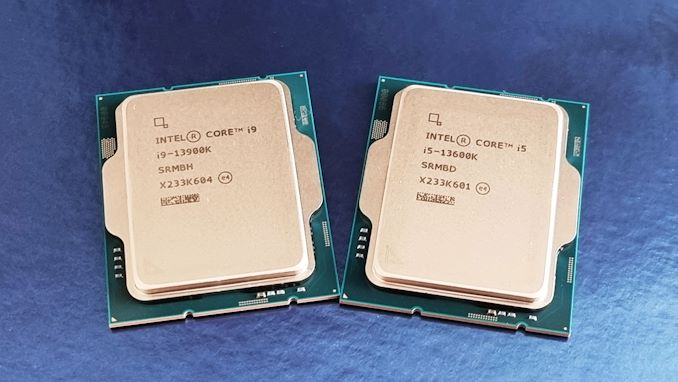
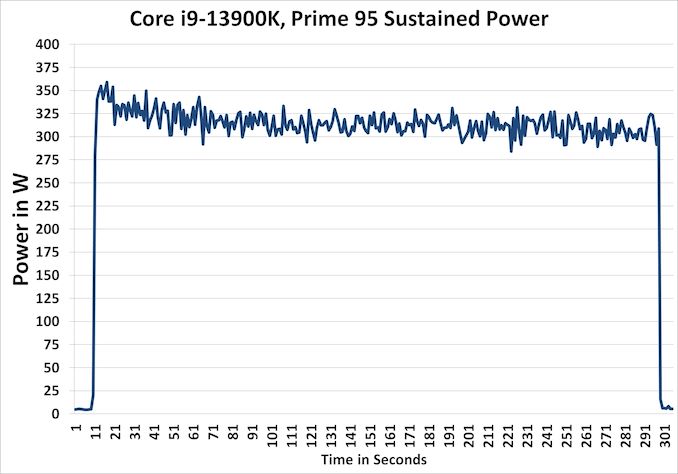








169 Comments
View All Comments
Nero3000 - Thursday, October 20, 2022 - link
Correction: the 12600k is 6P+4E - table on first pageHixbot - Thursday, October 20, 2022 - link
I am hoping for an high frequency 8 core i5 with zero ecores and high cache. It's would be a gamer sweet spot, and could counter the inevitable 3d cache Zen 4.nandnandnand - Friday, October 21, 2022 - link
big.LITTLE isn't going away. It's in a billion smartphones, and it will be in most of Intel's consumer CPUs going forward.Just grab your 7800X3D, before AMD does its own big/small implementation with Zen 5.
HarryVoyager - Friday, October 21, 2022 - link
Honestly, I'm underwhelmed by Intel's current big.LITTLE setup. As near as I can tell, under load the E cores are considerably less efficient than the P cores are, and currently just seem to be there so Intel can claim multi-threading victories with less die space.And with the CPU's heat limits, it just seems to be pushing the chip into thermal throttling even faster.
Hopefully future big.LITTLE implementations are better.
nandnandnand - Friday, October 21, 2022 - link
Meteor Lake will bring Redwood Cove to replace Golden/Raptor Cove, and Crestmont to replace Gracemont. Gracemont in Raptor Lake is the same as in Alder Lake except for more cache, IIRC. All of this will be on "Intel 4" instead of "Intel 7", and the core count might be 8+16 again.Put it all together and it should have a lot of breathing room compared to the 13900K(S).
8+32 will be the ultimate test of small cores, but they're already migrating on down to the cheaper chips like the 13400/13500.
Hixbot - Saturday, October 22, 2022 - link
Yes it does seem backwards that the more efficient architecture is in the P core. Reducing power consumption for light tasks seems better to keep it on the P core and downclock. I don't see the point of the "e" cores as effiency, but rather academic multithreaded benchmark war. Which isn't serving the consumer at all.deil - Monday, October 24, 2022 - link
E is still useful, as you get 8/8 cores in space where you could cram 2/4. I agree E for efficiency should be B as background to make it clearer what's the point. They are good for consumers as they offer all the high speed cores for main process, so OS and other things dont slow down.I am not sure if you followed, but intel cpu's literally doubled in power since they appeared, and at ~25% utilization, cpu's halved power usage. What you should complain about is bad software support, as this is not something that happens in the background.
TEAMSWITCHER - Monday, October 24, 2022 - link
I don't think you are fully grasping the results of the benchmarks. Compute/Rendering scores prove that e-cores can tackle heavy work loads. Often trading blows with AMD's all P-Core 7950X, and costing less at the same time. AMD needs to lower all prices immediately.haoyangw - Monday, October 24, 2022 - link
That's an oversimplification actually, P-cores and E-cores are both efficient, just for different tasks. The main efficiency gain of P-cores is it's much much faster than E-cores for larger tasks. Between 3 and 4GHz, P-cores are so fast they finish tasks much earlier than e-cores so total energy drawn is lower. But E-cores are efficient too, just for simple tasks(at low clockspeeds). Below 3GHz and above 1GHz, e-cores are much more efficient, beating P-cores in performance while drawing less power.Source: https://chipsandcheese.com/2022/01/28/alder-lakes-...
Great_Scott - Friday, November 25, 2022 - link
Big.LITTLE is hard to do, and ARM took ages and a lot of optimization before phone CPUs got much benefit from it.The problem of the LITTLE cores not adding anything in the way of power efficiency is well-known.
I'm saddened that Intel is dropping their own winning formula of "race-to-sleep" that they've successfully used for decades for aping something objectivly worse because they're a little behind in die shrinking.